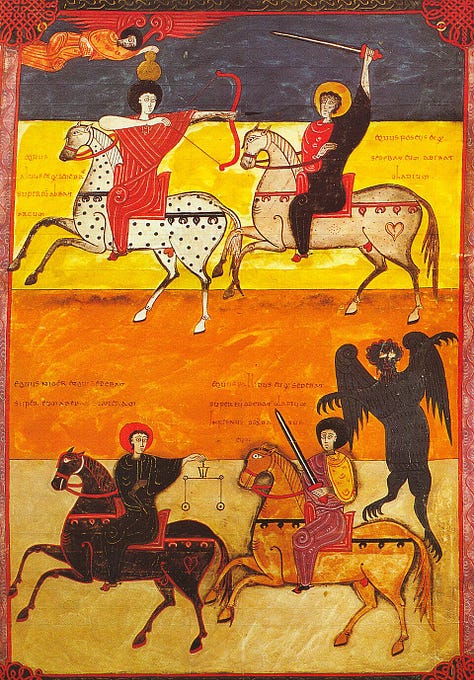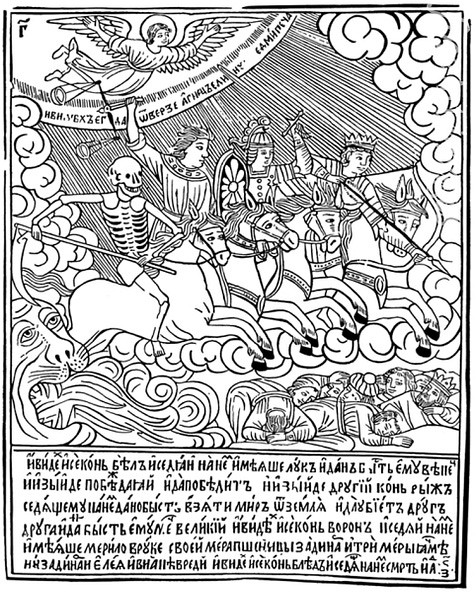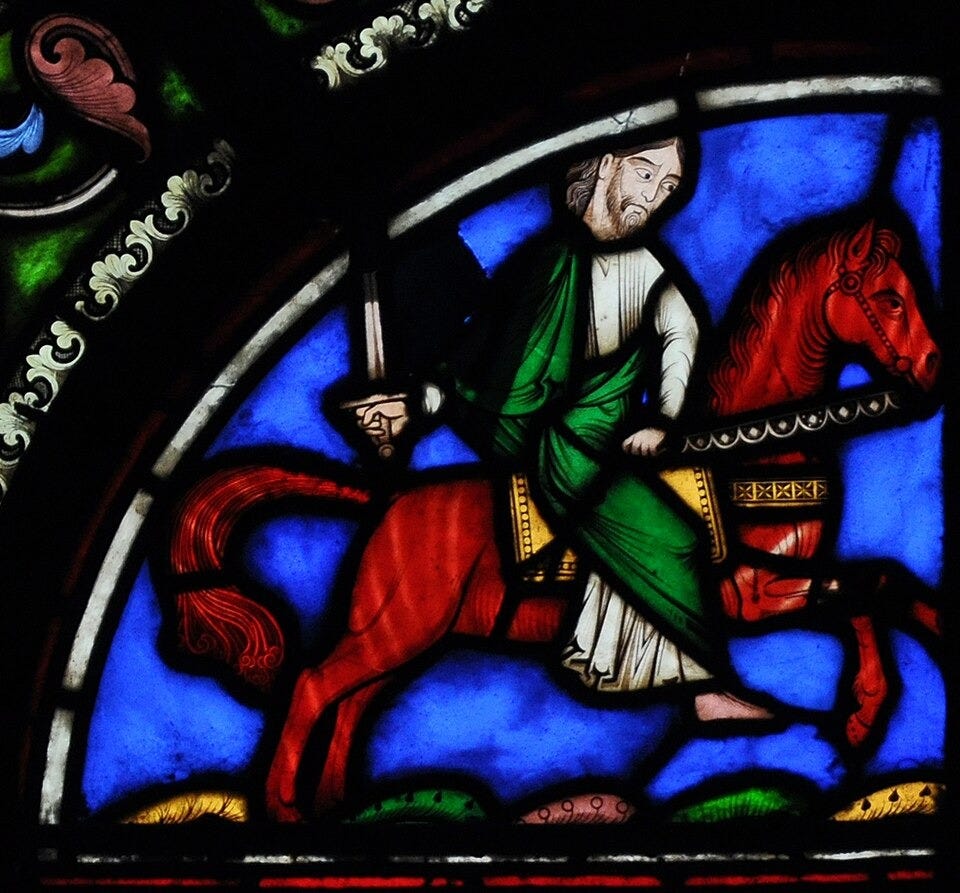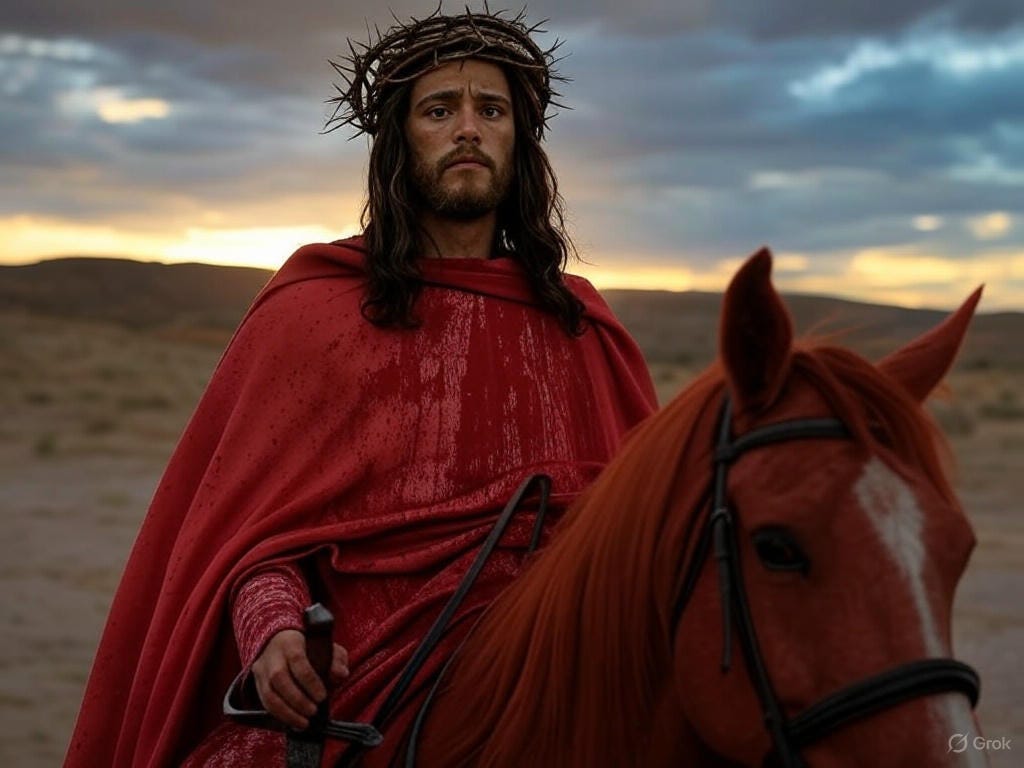Audio Version!
And when He opened the second seal I heard the second living creature saying, Come. And out came another horse, a red one, and the one sitting on it—there was given to him to take peace from the earth, and so they slay one another, and there was given to him a large sword.
In part 1, I added a bit more evidence that Jesus was the topic of all the seals, and that he was the rider on each horse, not just the white horse.
In this post, we directly face the identification for the red horse.
Throughout the history of interpretation of this second horse, the (vast) majority of commenters have turned to other options: Satan, the Antichrist, or “War”/“Violence” as a personification of the rider (like they do with “Death” in the fourth seal). Preterists and historicists try to identify a political actor who has meted out extreme violence, especially the Romans. Some see the slaughter as including Christian martyrs.



And in fact this basic approach is a a fairly easy thing to argue.
The color red is associated with war and violence, peace is taken from the earth, people slay one other, and a great sword appears.
How can any of this have to do with Jesus?
Most answer, “nothing.”
It’s not even conceived as a possibility.
Perhaps one response would that if the violence implied here comes directly from divine fiat (God), then our whole conception of the gospel is upended.
Surely neither God nor the Lamb is like this!
Yet many do see God as the One who allows this violence in his larger purposes, but the perpetrator of the violence could not possibly be the Lamb. It must be an evil actor consistent with Satan, or the Antichrist of the first horse, as they argue.
The reality is way more complicated.
Of course, I have the rare view that Jesus was the rider on each horse: Jesus opened each seal and he is the main focus of each seal.
Only a handful or less of interpreters have offered the alternative of Jesus as rider, one the sixth century Christian Oecumenius, whose commentary was discovered in the late 1800s, another a Benedictine monk in the 800s Berengaudus, and a third a 17th century Jesuit priest Luis del Alcázar, and perhaps a few others.
Count me among these few!
For the second seal, once again an application of logic, metaphor, and Scripture work toward this identification of Jesus as rider on the red horse.
But beyond that basic identification, discerning the meaning of the final part of 6:4 is even more difficult and perhaps more significant.
So let’s go slowly.
(continued)
In Plain Sight is a subscriber supported publication. If you appreciate the content and insights of this Substack, please consider a paid subscription. Subscribers receive additional material at the end of most posts with more subscriber only material to come.
Blood in Revelation
And out came another horse, a red one.
Though only used once in Revelation, the color red is the prevailing image in these verses.
As the earliest interpreters understood (and interpreters since of every kind), this red is the color of blood.*
The horse is blood colored, slaying one another produces blood, and great swords are used for killing.
Lots of blood, and even more.
Revelation is a bloody book.
Just the term “blood (Greek haima)” occurs nineteen times, not to mention slaughter and weaponry that causes bloodshed.
But …
The Lamb who opened this seal was “standing as slaughtered.”
He was bloodied.
And the second living creature?
The ox—an animal regularly used in sacrifices.
As I have suggested before, the rider on the red horse is Jesus—and red because of Jesus.
And the primary references to blood in Revelation refer to—you guessed it—Jesus.
The blood of Jesus is the first mention of blood in Revelation (1:5: “To him who loves us and washed us from our sins by his blood.)
And again in 5:9 and 7:14 and 12:11 (all the blood of the Lamb).
There is also a bloody moon (6:12), bloody hail (8:7); bloody water (8:8; 11:6; 16:3, 4; blood from a winepress flowing almost 200 miles and five feet high (14:20); the blood of prophets and saints (16:6; 17:6; 18:24; 19:2). We’ll take up those in time.
The final mention of blood is also Jesus. In Revelation 19:13, John sees the rider on the white horse “clothed with a robe dipped in blood.”
As you might imagine, the varied uses of blood throughout Revelation are ripe for interpretation as metaphors, but somehow related to the reality of the bloody cross.
The Rider
So I believe, with good reason, that the rider on the red horse, like the white horse, was Jesus.
The creature who introduced the white horse was lion-faced, and called out the victorious Lion of Judah whose incarnation proclaimed the Kingdom of God.
The same Jesus, this time as the sacrificial Lamb, was on a red horse, indicative of his (bloody) sacrifice—and also indicated by the ox-faced creature (see part 1).
Thus far, easy.
What comes after is the difficult part.
(cont.)
Peace from the earth
There was given him to take peace from the earth … and there was given to him a great sword.
This phrase and the following one have caused interpreters throughout the ages to see the rider as Satan or his deputy and the horse as war and conflict.
As I said above, there seems to be an aversion to connecting the seemingly violent picture with God or (especially) Jesus.
But both are definitely involved if Jesus is the rider.
This sentence almost looks like permission, but is actually a commission.
The agent is God and Jesus is the recipient of that commission: “there was given [by God] to him [Jesus] to take peace from the earth …”
How could this be?
It could be because Jesus already said this during his earthly ministry!
Or maybe Jesus said it during his ministry because of this commission.
Jesus directly stated this commission during his earthly ministry: “Don’t think that I came to bring peace on the earth; I came not to bring peace, but a sword” Matthew 10:34.
Luke 12:51 has virtually the same: “Do you think that I have come to give peace on the earth? No, I tell you, but division.”
Just this crystal clear connection to Jesus’s teachings makes the identification of the rider with Jesus fairly easy.
It may be the most troubling statement of all he said, but he certainly did say it, and the vision of the second horse is very consistent.
Of course, there is a lot of theology to be unpacked in this statement, but that will come. Another post is ahead!
“So they might slay one another”
This short phrase tucked between only makes the identification of Jesus easier.
In the same passages in Matthew and Luke quoted above we read the following:
“For I came to divide a man against his father, and daughter against her mother, and bride against her mother-in-law, and the enemies of a man are his own household” Matthew 10:35–36.
“From now on five will be divided in a household three against two and two against three, father will be divided against son and son against father, mother against daughter and daughter against mother, mother-in-law against her [son’s] bride, and bride against mother-in-law” Luke 12:52–53.
Because of Jesus, “peaceful” households become war-torn.
Whether physically or figuratively, “slay one another” is a good summation of Jesus’s words.
But there is actually much more substance behind these words that relate to the cross of Jesus. Once again I’ll take this up in the next post.
Peace and swords
When I wrote my very first post on Substack two years ago—Peace and Swords—I had no idea that I would be here today writing on Revelation 6:4 and referring back to it. Yet everything I said there holds true and I encourage you to go back and read it.
The second seal, though, brings the images of peace, slaughter, and sword to a completely different plane of vivid illustration.
But it also brings a more intense need for theological interpretation with deeply practical insight for our world, then and now.
In part three on the Second Seal, I will attempt an understandable interpretation of 6:4. Stay tuned.
*Oecumenius was direct: “The red horse is a figure of blood,” ὁ πυρρὸς ἵππος αἵματος αἴνιγμα τυγχάνει. I have a translation of Oecumenius’s commentary on this section in the paid area.
Observations on the Greek Text of Revelation (and commentary of Oecumenius)
Καὶ ὅτε ἤνοιξεν τὴν σφραγῖδα τὴν δευτέραν,
And when he opened the seal the second,
ἤκουσα τοῦ δευτέρου ζῴου λέγοντος· ἔρχου.
I heard the second living creature saying, come.
Keep reading with a 7-day free trial
Subscribe to In Plain Sight to keep reading this post and get 7 days of free access to the full post archives.



